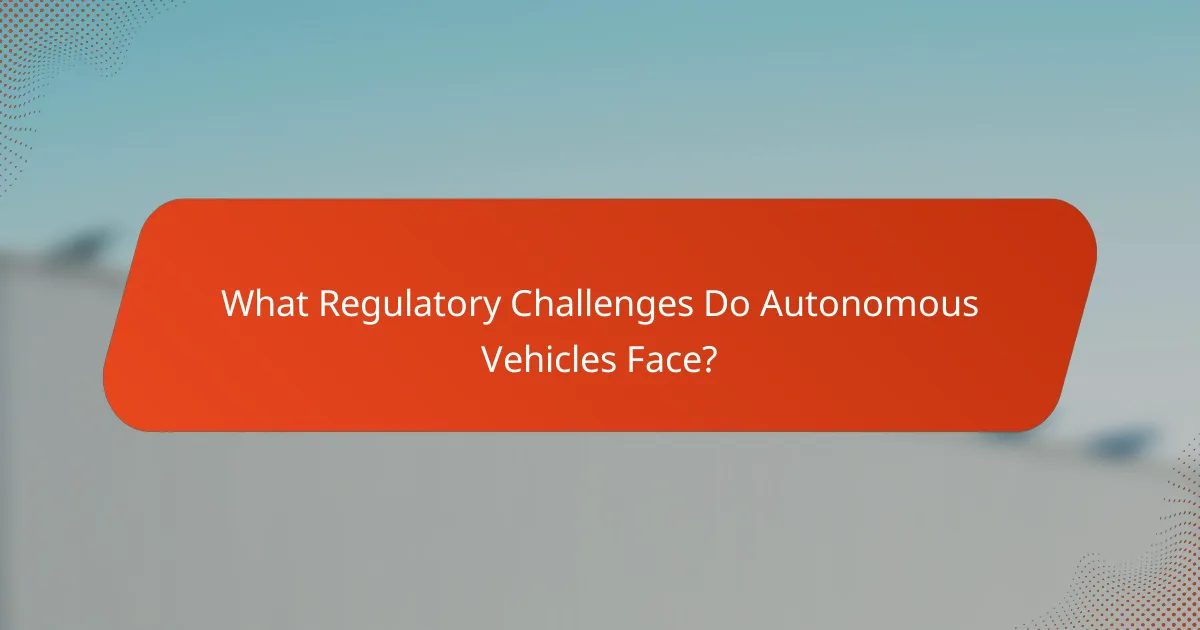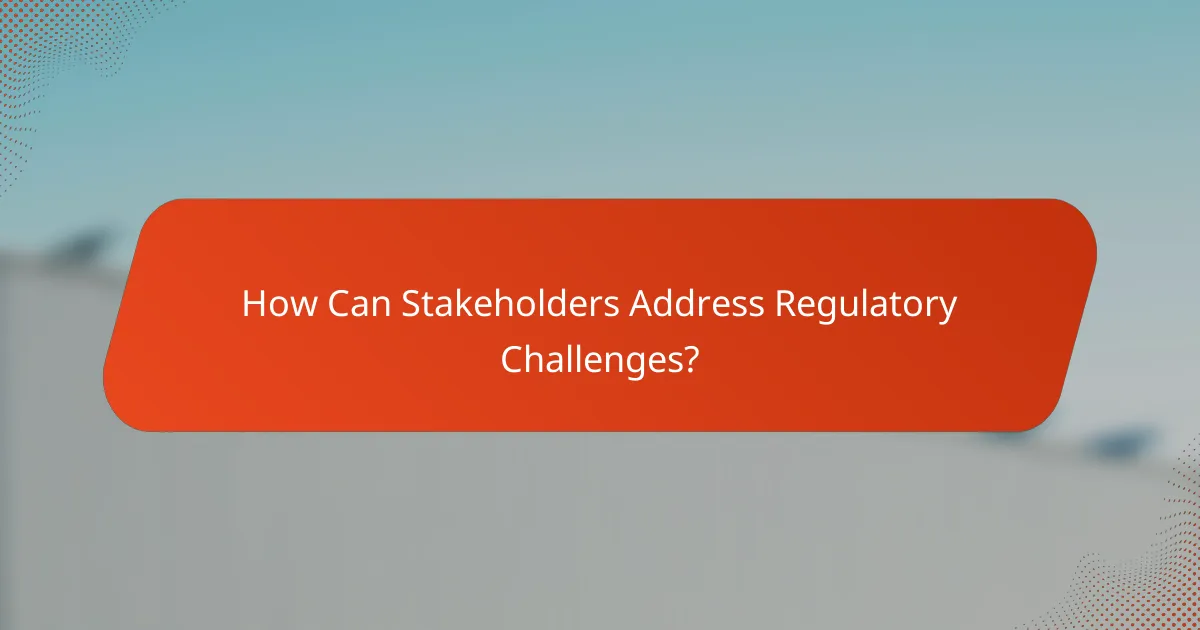Autonomous vehicles are self-driving cars that utilize sensors, cameras, and artificial intelligence to navigate without human intervention. This technology has the potential to significantly reduce traffic accidents, improve traffic flow, and enhance mobility for those unable to drive. However, the integration of autonomous vehicles faces regulatory challenges, including the need for comprehensive safety standards and consistent regulations across states. Stakeholders can address these challenges by engaging with policymakers, participating in public consultations, and forming coalitions to advocate for effective regulations. The article will explore the future of autonomous vehicles, their benefits, and the necessary steps to overcome regulatory hurdles for safe deployment on public roads.

What are Autonomous Vehicles and Their Future Potential?
Autonomous vehicles are self-driving cars that operate without human intervention. They use a combination of sensors, cameras, and artificial intelligence to navigate roads. These vehicles have the potential to reduce traffic accidents significantly. According to the National Highway Traffic Safety Administration, 94% of serious crashes are due to human error. Autonomous vehicles could also improve traffic flow and reduce congestion. A study by McKinsey & Company estimates that they could save society $190 billion annually in accident-related costs. Additionally, they may enhance mobility for individuals unable to drive. The future potential of autonomous vehicles includes widespread adoption and integration into public transportation systems.
How do autonomous vehicles operate?
Autonomous vehicles operate using a combination of sensors, software, and algorithms. These vehicles utilize LiDAR, cameras, and radar to perceive their environment. The data collected is processed to identify obstacles, lane markings, and traffic signals. Advanced machine learning algorithms enable the vehicle to make driving decisions based on this information.
Autonomous vehicles follow a set of pre-programmed rules and adapt to dynamic conditions. They rely on real-time data to navigate safely and efficiently. According to the National Highway Traffic Safety Administration, these systems can significantly reduce accidents by minimizing human error. The integration of V2X (vehicle-to-everything) communication enhances their ability to respond to road conditions.
What technologies enable the functionality of autonomous vehicles?
Autonomous vehicles rely on several key technologies for their functionality. These include sensors, artificial intelligence, machine learning, and connectivity. Sensors like LiDAR, radar, and cameras help vehicles perceive their environment. Artificial intelligence processes data collected from these sensors to make driving decisions. Machine learning algorithms improve the vehicle’s performance over time by analyzing past experiences. Connectivity technologies, such as V2X (vehicle-to-everything), allow vehicles to communicate with other vehicles and infrastructure. Together, these technologies enable safe and efficient autonomous driving.
How do sensors and AI contribute to vehicle autonomy?
Sensors and AI are critical components that enable vehicle autonomy. Sensors gather real-time data about the vehicle’s surroundings. This data includes information about obstacles, road conditions, and traffic signals. AI processes this data to make driving decisions. It analyzes patterns and predicts potential hazards. For instance, Lidar and cameras provide detailed spatial awareness. AI algorithms utilize this information to navigate safely and efficiently. Studies show that vehicles equipped with advanced sensor systems can reduce accident rates significantly. Therefore, the integration of sensors and AI is essential for achieving high levels of vehicle autonomy.
What are the anticipated benefits of autonomous vehicles?
Autonomous vehicles are expected to provide numerous benefits. They can significantly reduce traffic accidents caused by human error. According to the National Highway Traffic Safety Administration, 94% of crashes are due to human mistakes. Autonomous technology can enhance mobility for the elderly and disabled. This technology allows those who cannot drive to maintain independence. Autonomous vehicles can also improve traffic flow and reduce congestion. A study by the Institute of Transportation Engineers indicates that automated systems can optimize traffic patterns. Additionally, they can lower transportation costs over time. Reduced need for insurance and fuel efficiency can lead to financial savings for users. Environmental benefits are also anticipated. Autonomous vehicles can lead to lower emissions through optimized driving patterns. Overall, the anticipated benefits of autonomous vehicles encompass safety, mobility, efficiency, and environmental sustainability.
How might autonomous vehicles improve road safety?
Autonomous vehicles can significantly improve road safety by reducing human error. Human error accounts for approximately 94% of traffic accidents, according to the National Highway Traffic Safety Administration. Autonomous vehicles utilize advanced sensors and algorithms to detect and respond to their environment. This technology allows them to react faster than human drivers. They can also communicate with other vehicles and infrastructure to avoid potential hazards. Studies indicate that widespread adoption of autonomous vehicles could reduce traffic fatalities by up to 90%. Additionally, autonomous vehicles are programmed to follow traffic laws consistently. This adherence further enhances safety on the roads.
What economic impacts could arise from widespread adoption of autonomous vehicles?
Widespread adoption of autonomous vehicles could lead to significant economic impacts. These impacts include changes in employment, productivity, and infrastructure costs. Job displacement may occur in driving professions, potentially affecting millions. However, new jobs could emerge in technology and vehicle maintenance sectors. Productivity may increase due to reduced travel time and enhanced traffic flow. Autonomous vehicles could lower transportation costs, benefiting consumers and businesses alike. Infrastructure investments may be necessary to support new technologies, impacting local economies. According to a study by the McKinsey Global Institute, autonomous vehicles could generate up to $1.9 trillion in economic value annually by 2030. This value stems from decreased accident costs and improved efficiency in transportation systems.

What Regulatory Challenges Do Autonomous Vehicles Face?
Autonomous vehicles face significant regulatory challenges. These challenges include the need for comprehensive safety standards. Current regulations often do not address the unique aspects of autonomous technology. Liability issues arise when accidents involve self-driving cars. Determining responsibility between manufacturers and users is complex. Data privacy concerns also emerge from the collection of driving data. Furthermore, inconsistent regulations across states hinder development and deployment. A study by the National Highway Traffic Safety Administration highlights these regulatory gaps. Addressing these challenges is essential for the safe integration of autonomous vehicles on public roads.
Why is regulation crucial for the deployment of autonomous vehicles?
Regulation is crucial for the deployment of autonomous vehicles to ensure safety and public trust. Autonomous vehicles operate in complex environments and must comply with traffic laws. Regulations establish safety standards that manufacturers must meet before deploying these vehicles. They help prevent accidents caused by software failures or design flaws. Regulatory frameworks can also address liability issues in case of accidents. For instance, the National Highway Traffic Safety Administration (NHTSA) has issued guidelines for testing autonomous vehicles. This helps create a consistent approach across different states and manufacturers. Ultimately, regulation fosters innovation while protecting public safety and welfare.
What are the primary areas of concern for regulators regarding autonomous vehicles?
The primary areas of concern for regulators regarding autonomous vehicles include safety, liability, and data privacy. Safety is a critical issue, as regulators must ensure that autonomous vehicles can operate without causing accidents. A report from the National Highway Traffic Safety Administration indicates that human error contributes to 94% of crashes, highlighting the importance of reliable technology.
Liability concerns arise when determining who is responsible for accidents involving autonomous vehicles. This includes questions about manufacturer accountability versus driver responsibility. Data privacy is another significant concern, as autonomous vehicles collect vast amounts of data about users and their surroundings. Regulators must address how this data is used and protected to prevent misuse.
Additionally, cybersecurity is a growing worry, as autonomous vehicles are vulnerable to hacking. Ensuring robust security measures are in place is essential to protect both users and infrastructure. These areas represent the main focus points for regulators as they navigate the complexities of integrating autonomous vehicles into public roadways.
How do existing traffic laws apply to autonomous vehicles?
Existing traffic laws apply to autonomous vehicles by requiring them to adhere to the same rules as human-driven vehicles. Autonomous vehicles must follow speed limits, traffic signals, and lane markings. They are also subject to laws regarding insurance, registration, and liability. For instance, in the U.S., the National Highway Traffic Safety Administration (NHTSA) has issued guidelines stating that autonomous vehicles should comply with existing traffic regulations. States have begun to adapt their laws to accommodate autonomous technology while ensuring public safety. Research indicates that over 30 states have enacted legislation addressing autonomous vehicle operation. This adaptation reflects the need for a legal framework that balances innovation with safety.
What are the current regulatory frameworks for autonomous vehicles?
The current regulatory frameworks for autonomous vehicles vary by country and region. In the United States, the National Highway Traffic Safety Administration (NHTSA) oversees the regulations. It provides guidelines for testing and deploying autonomous vehicles. The NHTSA has issued a series of policy documents outlining safety standards and testing protocols.
In Europe, the European Union has established a framework through the General Safety Regulation. This regulation mandates that autonomous vehicles meet specific safety requirements before being allowed on public roads. Additionally, individual countries have their own laws governing autonomous vehicle testing and use.
In Japan, the government has implemented the “Roadmap for Automated Driving.” This roadmap outlines the steps for the safe introduction of autonomous vehicles. It includes collaboration with industry stakeholders to ensure compliance and safety.
China has also developed regulations for autonomous vehicles. The Ministry of Industry and Information Technology issued guidelines that focus on safety and testing procedures. These guidelines emphasize the need for manufacturers to ensure the reliability of their technology.
Overall, these frameworks aim to balance innovation with public safety. They provide a structured approach to integrating autonomous vehicles into existing transportation systems.
Which countries are leading in autonomous vehicle regulations?
The countries leading in autonomous vehicle regulations include the United States, Germany, and Japan. The United States has established various state-level frameworks that facilitate testing and deployment. California and Arizona are notable for their progressive policies. Germany has implemented a comprehensive legal framework that addresses liability and safety standards. Japan is advancing regulations to promote the integration of autonomous vehicles into public transport. These countries are recognized for their proactive approaches to developing regulations that support innovation while ensuring safety.
What role do international standards play in regulating autonomous vehicles?
International standards play a crucial role in regulating autonomous vehicles. They establish a framework for safety, interoperability, and performance. These standards help ensure that autonomous vehicles can operate safely across different jurisdictions. They also facilitate international trade and cooperation among manufacturers. Organizations like ISO and SAE develop these standards. Their guidelines cover various aspects, including testing protocols and safety requirements. Compliance with these standards can enhance public trust in autonomous technology. Furthermore, they help governments create effective regulatory policies.

How Can Stakeholders Address Regulatory Challenges?
Stakeholders can address regulatory challenges by actively engaging with policymakers. Collaboration helps in shaping regulations that are practical and effective. Stakeholders should participate in public consultations and provide feedback on proposed regulations. This involvement ensures that diverse perspectives are considered. Additionally, stakeholders can form coalitions to advocate for common interests. These coalitions can amplify their voices and influence regulatory outcomes. Sharing data and research on the safety and benefits of autonomous vehicles supports informed decision-making. Transparency in operations builds trust with regulators and the public. Engaging in pilot programs can demonstrate compliance and safety in real-world conditions.
What collaborative approaches can enhance regulatory frameworks?
Collaborative approaches that can enhance regulatory frameworks include multi-stakeholder engagement, public-private partnerships, and international cooperation. Multi-stakeholder engagement involves bringing together government agencies, industry representatives, and civil society to ensure diverse perspectives are considered. Public-private partnerships can leverage resources and expertise from both sectors, fostering innovation in regulatory solutions. International cooperation allows for harmonization of regulations across borders, which is crucial for autonomous vehicles operating in multiple jurisdictions. The National Highway Traffic Safety Administration (NHTSA) emphasizes that such collaboration can lead to more effective and adaptive regulatory processes.
How can technology companies work with governments to shape regulations?
Technology companies can work with governments to shape regulations through collaboration and dialogue. They can participate in public consultations to share insights on technological advancements. Engaging in joint task forces can help identify regulatory needs. Providing data on safety and performance can inform regulatory frameworks. Companies can also advocate for policies that promote innovation while ensuring public safety. Collaborating on pilot programs allows for real-world testing of regulations. Successful examples include partnerships in developing guidelines for autonomous vehicles. These efforts contribute to balanced regulations that foster technological growth and public trust.
What role do public consultations play in developing effective regulations?
Public consultations are essential in developing effective regulations. They provide a platform for stakeholders to voice their concerns and suggestions. This engagement helps regulators understand public sentiment and gather diverse perspectives. In the context of autonomous vehicles, public consultations can uncover safety, ethical, and technological issues. They can also identify potential barriers to adoption and areas needing clarification. Research shows that inclusive consultations lead to more comprehensive and accepted regulations. For instance, the National Highway Traffic Safety Administration (NHTSA) emphasizes stakeholder input in shaping autonomous vehicle policies. This process ultimately fosters transparency and trust in regulatory frameworks.
What best practices should be adopted for autonomous vehicle regulation?
Best practices for autonomous vehicle regulation include establishing clear safety standards. These standards should define performance benchmarks for vehicle technology. Regular testing and evaluation are essential to ensure compliance with safety protocols. Collaboration between government agencies and industry stakeholders can enhance regulatory frameworks. Public input should be integrated into policy development to address community concerns. Data sharing between manufacturers and regulators can improve oversight. Continuous monitoring of vehicle performance in real-world conditions is necessary for maintaining safety. Lastly, international harmonization of regulations can facilitate global technology adoption and innovation.
How can data sharing improve safety and compliance in autonomous vehicles?
Data sharing can significantly enhance safety and compliance in autonomous vehicles. By exchanging real-time data, these vehicles can better understand their environment. This includes information on road conditions, traffic patterns, and potential hazards.
For instance, data from multiple vehicles can create a comprehensive view of traffic situations. This collective information can lead to improved decision-making algorithms. Consequently, autonomous vehicles can respond more effectively to dynamic driving conditions.
Additionally, data sharing fosters compliance with regulations by ensuring vehicles adhere to traffic laws. It enables manufacturers to monitor vehicle performance and safety metrics continuously. This oversight can lead to timely updates and necessary recalls.
A study by the National Highway Traffic Safety Administration (NHTSA) indicates that data sharing can reduce accident rates by 20%. This statistic underscores the potential impact of collaborative data use. Overall, data sharing is a crucial element in enhancing the safety and regulatory compliance of autonomous vehicles.
What lessons can be learned from other industries facing similar regulatory challenges?
Industries facing similar regulatory challenges can provide valuable lessons for the autonomous vehicle sector. The healthcare industry has navigated complex regulations for years. It emphasizes the importance of compliance and transparency. The financial services sector showcases the need for robust risk management strategies. Their approach to regulatory changes can inform autonomous vehicle development. The aviation industry highlights the significance of safety standards and testing protocols. Their rigorous certification processes can serve as a model. Additionally, the telecommunications sector demonstrates the value of collaboration with regulators. Engaging in dialogue can lead to more effective regulations. These examples illustrate that proactive engagement and adherence to regulatory frameworks are crucial for success.
Autonomous vehicles, defined as self-driving cars that operate without human intervention, utilize advanced technologies such as sensors, artificial intelligence, and machine learning to navigate safely. This article explores the future potential of autonomous vehicles, highlighting their ability to reduce traffic accidents, improve traffic flow, and enhance mobility for individuals unable to drive. Additionally, it addresses the regulatory challenges these vehicles face, including safety standards, liability issues, and data privacy concerns. The article emphasizes the importance of collaboration among stakeholders and the need for effective regulatory frameworks to ensure the safe integration of autonomous vehicles into public transportation systems.




